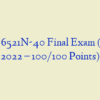Description
NURS-6521N-33-Advanced Pharmacology-2021-Winter-QTR- Term-wks-1-thru-11
Exam – Week 11
100 out of 100 points
- Which antibiotic requires administration of a loading dose?
- A 72-year-old patient is prescribed ophthalmic ciprofloxacin for a bacterial infection in her right eye. The nurse will teach her to observe for which of the following adverse effects of the drug?
- Ms. Lewis Is in 74-year-old female who presents to your clinic for routine visit today. You review her medical record and notice she is prescribed aspirin therapy. You provide patient education regarding the signs of aspirin toxicity. An early sign of aspirin toxicity is:
- A Nurse Practitioner will instruct a patient taking allopurinol to take each dose
- Which test should the NP order for monitoring effectiveness of the patient receiving heparin?
- Which of the following is a true statement about aspirin and its action on platelets
- A 5-year-old boy needs an IM injection. The least painful and most effective injection site would be the
- All insects have an FDA black box warning regarding
- A patient with bipolar disorder is ondival proexsodium (Depakote) formania.Whatest(s)would the family nurse practitioner monitor?
- A 46-year-old man is receiving a quinupristin/dalfopristin IV infusion for a life-threatening infection. Which of the following would be most important for the nurse to monitor?
- A 33-year-old man has developed acute gouty arthritis. He has been prescribed colchicine. When developing a care plan for this patient, which factor will be most important for the nurse to consider?
- Pernicious anemia is treated with
- A 6-month-old child has developed skin irritation due to an allergic reaction. He has been prescribed a topical skin ointment. The nurse will consider which of the following before administering the drug?
- Laboratory testing has confirmed that a patient has chloroquine-resistant malaria and the patient’s physician has prescribed quinine along with an adjunctive drug. The nurse should question the physician’s order if the patient has a history of
- Which of the following would a Nurse Practitioner assess for in a patient who is taking polymyxin B systemically?
- A Nurse Practitioner is assigned to a patient who is at 32 weeks’ gestation and is receiving terbutaline (Brethine) IV for 24 hours to control preterm labor. Which of the following nursing actions will the nurse take to decrease the risk of hypotension and promote circulation to the fetus?
- A patient will soon begin targeted therapy as a component of her treatment plan for chronic leukemia. The nurse is conducting health education about this new aspect of the patient’s drug regimen and the patient has asked about the potential side effects of treatment. How should the nurse best respond?
- A contraindication to the use of combined contraceptives is:
- The Nurse Practitioner has established peripheral IV access and begun an infusion of magnesium sulfate on a 29-year-old antepartum patient who is 35 weeks pregnant. Which of the following assessment findings most likely prompted the patient’s physician to order magnesium sulfate for this patient?
- A woman is receiving prolonged drug therapy during her complicated pregnancy, and it may pose a risk to both the mother and the fetus. The primary care physician has made dosage adjustments to minimize adverse effects and prevent toxicity. The nurse should make sure
- An elderly woman is slated for a hemiarthroplasty (hip replacement surgery) after falling and breaking her hip on the stairs outside her home. The woman’s pain in the time since her injury has been severe, and her care team has been treating it with morphine. Which of the following administration schedules is most likely to control the patient’s pain?
- Alprostadil (Caverject), a drug used to treat erectile dysfunction, has been prescribed to a 42-year-old patient. When providing education to the patient and his wife, the nurse should inform the wife about which of the following adverse effects?
- A male patient is receiving heparin by continuous intravenous infusion. The nurse will instruct the patient and family members to report which of the following should it occur?
- A 51-year-old female patient has been receiving doxorubicin (Adriamycin) for metastatic breast cancer. Her medical record indicates she has cardiomyopathy and a cumulative dose of 300 mg/m2 of doxorubicin. Which of the following measures would help limit the severity of the cardiomyopathy in this patient?
- A woman who is in the second trimester of her first pregnancy has been experiencing frequent headaches and has sought advice from her nurse practitioner about safe treatment options. What analgesic can the nurse most safely recommend?
- A postmenopausal patient is prescribed bisphosphonates to treat osteoporosis. The nurse will instruct the patient to take the drug
- A female patient is taking oral cyclophosphamide therapy for breast cancer. Because of possible adverse effects of the drug, the nurse will instruct the patient to do which of the following?
- A Nurse Practitioner works at a weight management clinic. To which of the following overweight patients could the nurse safely administer dextroamphetamine?
- A 65-year-old woman has an advanced form of rheumatoid arthritis. Her treatment includes a regular dosage of methotrexate. The APRN will advise her to take which of the following vitamin supplements while taking the drug?
- A 66-year-old man has made an appointment with his primary care provider to discuss his recent erectile dysfunction (ED) and has requested a prescription for tadalafil (Cialis) based on television commercials he has seen. What characteristic of this patient would most likely contraindicate the use of tadalafil for his ED?
- A patient is receiving long-term clindamycin therapy for a life-threatening infection. The nurse will begin by monitoring this drug therapy by obtaining
- A patient has been admitted to the critical care unit of the hospital with bacterial septicemia that has failed to respond to initial antibiotic treatment. The patient’s most recent blood cultures reveal the presence of methicillin-resistant Staphylococcus aureus (MRSA) in the patient’s blood. The nurse will anticipate that this patient will likely require intravenous administration of what antibiotic?
- A nurse practitioner has administered filgrastim to a diverse group of patients in recent months. Which of the following patients should the nurse observe for extremely elevated white blood cell counts following administration of the drug?
- A Nurse Practitioner is caring for a 10-year-old boy who complains of chronic headaches. His mother reports that she gives him Tylenol at least three times a day. Which of the following will the nurse work with the physician to evaluate?
- A Nurse Practitioner will monitor which of the following when assigned to a patient taking allopurinol for chronic gout who visits the clinic every 2 months?
- A 66-year-old woman has experienced a significant decline in her quality of life as a result of worsening rheumatoid arthritis. Her physician has prescribed etanercept and the APRN is responsible for facilitating this new aspect of the patient’s drug regimen. This will involve the administration of
- Finasteride(Proscar)isprescribedfora50-year-oldmanwhoisexperiencingaproblem withurination secondarytoanenlargedprostate.Thepractitionerwouldteachthepatienthatwhileheistakingthis medication,itisimportanto:
- A Nurse Practitioner who provides care on a pediatric medicine unit has conducted a medication reconciliation of a recently-admitted patient. In light of the fact that the child takes methylphenidate (Ritalin), the nurse is justified in considering a history of what health problem?
- A Nurse Practitioner is caring for a patient who is on amphotericin B. On morning rounds the patient reports weakness, numbness, and a tingling sensation in his feet. What would be a priority action by the nurse?
- A 30-year-old woman who is in the first trimester of pregnancy has presented to her primary care provider with a 4-day history of a reddened, itchy left eye that is crusted with purulent exudate. The clinician suspects a bacterial, rather than viral, etiology. How will the patient’s pregnancy affect the potential use of ciprofloxacin to treat her conjunctivitis?
- A 7-year-old child has been taking tetracycline for a bacterial infection. The nurse will be sure to inform the parents that this drug could cause
- Lily, the nurse practitioner is seeing Mr. Reynolds today. She would recognize that which of the following is a potential adverse side effects of autonomic-anticholinergic agents?
- A Nurse Practitioner is assessing a patient who has chronic lymphoblastic myelogenous leukemia. The treatment plan includes hydroxyurea (Hydrea). The nurse will assess the patient for which of the following?
- A 39-year-old woman is receiving doxorubicin for the treatment of cancer. After each treatment, the patient has acute nausea and vomiting accompanied by a slightly increased heart rate. The nurse will advise her to
- Ms. Shackleford Has been placed on Ambien to help for her insomnia. The NP must educate the patient regarding the rapid onset of Ambien. Which statement below is correct?
- Thenursepractitionerhasprescribedelementaliron6mg/kg/dayinthre divideddosesforatoddler diagnosedwithiron-deficiencyanemia.Whatinstructionswouldthefamilynursepractitionerincludefor
- Mr. CW has his routine appointment today in your clinic. He has been taking 10 mg of prednisone per day for the past six months. He should be assessed for
- A Nurse Practitioner is to use a single-dose 1 mL vial to administer 0.5 mL of epoetin alfa to a 39-year-old woman who is being treated for chemotherapy-induced anemia. Which of the following will the nurse do with the unused portion of the drug?
- Jennifer, the Nurse Practitioner, is seeing Mr. Johns, a 65 year old male in the clinic today with c/o Arthritis pain. What is a serious side effect of ibuprofen use in the older adult patient?
- Whatisthebestinitialtreatmentplanforaslepdisorderintheolderadultpatient?
- A 20-year-old female patient is receiving topical clindamycin for acne vulgaris. She develops a rash and urticaria along with severe itching where the medication is applied. The nurse will formulate which of the following nursing diagnoses for the patient?
- A 62-year-old patient taking tamoxifen exhibits increased bone and tumor pain along with a local disease flare. The nurse interprets this as an indication of which of the following?
- The nurse practitioner orders Amoxicillin 500 mg tid? What is the total amount of medication patient will take per day?
- A Nurse Practitioner is discussing with a 58-year-old male patient the causes of erectile dysfunction in men over 50 years of age. Which of the following will the nurse inform the patient is the primary physical cause of erectile dysfunction of men in this age group?
- A patient is being seen in the emergency department for a sprained ankle and is given a drug to relieve pain. When a second dose of the pain medication is given, the patient develops redness of the skin, itching, and swelling at the site of injection of the drug. The most likely cause of this response is
- When planning care for a patient who is receiving filgrastim (Neupogen) for a nonmyeloid malignancy, the nurse should formulate which of the following patient outcomes? (Select all that apply.)
- A pregnant patient asks the Nurse Practitioner what over-the-counter medication she can take for recurring headaches. The nurse should recommend
- A nurse practitioner orders 150 mg of oral fluconazole for a patient with vulvovaginal candidiasis. The patient should expect to take medication
- A patient with AIDS has developed a number of secondary infections in recent weeks, including Kaposi’s sarcoma. As a result of this most recent diagnosis, his care team has opted to begin treatment with interferon alfa- 2a. The nurse is aware that this drug will address the etiology of Kaposi sarcoma by
- A patient asks the nurse practitioner about food sources such as soybeans and soy products. The nurse practitioner understands that these foods are considered
- Which of the following should not be taken with a selective serotonin reuptake inhibitor?
- A nurse practitioner has been assigned to a 55-year-old woman who has a malignant brain tumor. The patient is receiving her first dose of carmustine. It will be critical for the nurse to observe for which of the following?
- All of the following systemic drugs interfere with metabolism of oral contraceptives except
- A 60-year-old patient experienced a sudden onset of chest pain and shortness of breath and was subsequently diagnosed with a pulmonary embolism in the emergency department. The patient has been started on an intravenous heparin infusion. How does this drug achieve therapeutic effect?
- Morphine has been prescribed for a 28-year-old man with severe pain due to a back injury. The nurse will advise the patient to avoid
- A 19-year-old patient reports to a clinic with vaginal discharge with a foul odor. A microscopic exam reveals trichomonas vaginalis. The nurse practitioner is aware that
- A Nurse Practitioner is instructing a 19-year-old female patient on the use of fluconazole for candida vaginitis. A teaching priority will be to
- A patient has endocarditis and is taking gentamicin. The Nurse Practitioner will be sure to monitor which of the following?
- The NP has just placed Mr. Johnson on a selective serotonin reuptake inhibitor. What symptoms should be reviewed with the patient who is newly prescribed this class of medication?
- A Nurse Practitioner is working with a 16-year-old pregnant teen and assessing for behavior that may put the baby at risk. The most important assessment the nurse can make is
- A 36-year-old woman with a history of dysmenorrhea has begun treatment with progesterone, which she will be receiving by the intramuscular route. The nurse participating in the woman’s care should prioritize which of the following potential nursing diagnoses?
- Donald is a nurse practitioner student. He recognizes Which option below could be a secondary use for an anxiolytic medication?
- Mr. Samuels has been prescribed olanzapine (Zyprexa). The NP know that he should be monitored for:
- A Nurse Practitioner is performing patient education for a woman who has just been prescribed a bisphosphonate. Which of the following diagnostic and history findings would have prompted the woman’s care provider to prescribe a bisphosphonate?
- Ms. LW is on hyrdroxychloroquine (Plaquenil) for rheumatoid arthritis. Certain tests are recommended before a patient starts this medication. Which of the following is NOT recommended before starting Hydroxychoroquine (Plaquenil)?
- Which of the following would the nurse include in a teaching plan about the signs and symptoms of thrombophlebitis and thromboembolism that should be reported by a patient taking estrogen?
- A patient is receiving cefazolin in combination with anticoagulants. To minimize the adverse effects during therapy, the nurse will
- A 45-year-old female patient is prescribed ciprofloxacin to treat a bronchial infection. A nursing assessment revealed that she started taking daily vitamin supplements about 2 years ago. To maximize the therapeutic effects of the ciprofloxacin therapy, the nurse should advise the patient to
- The nurse recognizes that the potential for teratogenic drug effects is not static throughout the prenatal and postnatal periods. The potential for teratogenic effects is highest during
- A child with chronic allergic symptoms uses an intranasal steroid for control of symptoms. At this child’s annual well-child checkup, the NP should carefully review what?
- A 56-year-old woman will soon begin treatment of her overactive bladder with tolterodine (Detrol). What patient teaching should the nurse provide to this woman?
- A Nurse Practitioner is explaining to the parents of a 6-year-old child suffering from angina why nitroglycerin patches for chest pain would not be appropriate. Which of the following will the nurse include in an explanation?
- The NP is considering a medication to treat Ms. Robert’s Urinary Tract Infection. The NP knows that Trimethoprim sulfamethazole (Bactrim) Is contra indicated in which of the following conditions:
- After 6 months of unsuccessfully trying to conceive, a 31-year-old woman and her husband have sought a referral to a fertility specialist in order to explore their options. A nurse at the clinic should recognize that the woman may benefit from
- A 20-year-old woman has been prescribed estrogen. As with all women taking estrogen, the nurse will carefully monitor the patient for which of the following?
- A 43-year-old man has been diagnosed with active TB. He is prescribed a multiple drug therapy, including INH and rifampin. A priority assessment by the nurse will be to monitor which combination of laboratory test results?
- Phenytoin decreases folic acid absorption by
- A 3-year-old boy has developed otitis media and requires antibiotics. In order to increase the chance that the boy will take his prescribed medication, the nurse should
- A 71-year-old man has just been prescribed finasteride (Proscar). Which of the following complaints by this patient most likely indicated a need for this drug?
- A Nurse Practitioner is explaining the use of acyclovir therapy to a 72-year-old man. Nephrotoxicity is discussed as a major adverse effect in older patients. To minimize the risk of the patient developing this adverse effect, the nurse will advise him to
- Which of the following medications will not increase the likelihood of photosensitivity?
- A patient with non-Hodgkin’s lymphoma (NHL) will be starting a course of doxorubicin shortly. When planning this patient’s care, what nursing diagnosis should the nurse prioritize?
- The laboratory monitoring required when a patient is on a selective serotonin reuptake inhibitor is?
- A male patient has been brought to the emergency department during an episode of status epilepticus. Diazepam is to be administered intravenously. The APRN will be sure to
- A pregnant patient who has diabetes has been admitted to the hospital to begin labor. Since the patient has diabetes, the physician has decided to use oxytocin (Pitocin) to initiate labor contractions. When talking to the patient about the adverse effects of the drug, the nurse should understand that the most common adverse effects of the drug include
- A patient with chronic heart failure has begun treatment with epoetin alfa, which she will receive in her own home from a home health nurse. The nurse should teach the patient to supplement this treatment with a diet that is high in
- A school nurse has been teaching high school students about the risks associated with marijuana use. However, the nurse has been met with considerable skepticism on the part of students, most of whom believe that marijuana is a benign drug. Which of the following teaching points should the nurse provide?
- The anticoagulant drug that acts as a vitamin K antagonist is:
- Drugs have a valid medical use but a high potential for abuse, both psychological and physiologic. In an emergency, a Schedule 2 drug may be prescribed by telephone if a written prescription cannot be provided at the time. However, a written prescription must be provided within 72 hours with the words authorization for emergency dispensing written on the prescription. These prescriptions cannot be refilled. A new prescription must be written each time. Examples include certain amphetamines and barbiturates.
- A patient is to begin taking tobramycin (Nebcin) for a nosocomial infection. Which of the following assessments should the nurse prioritize?







